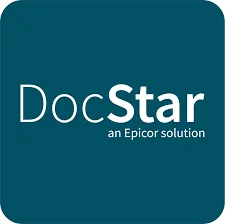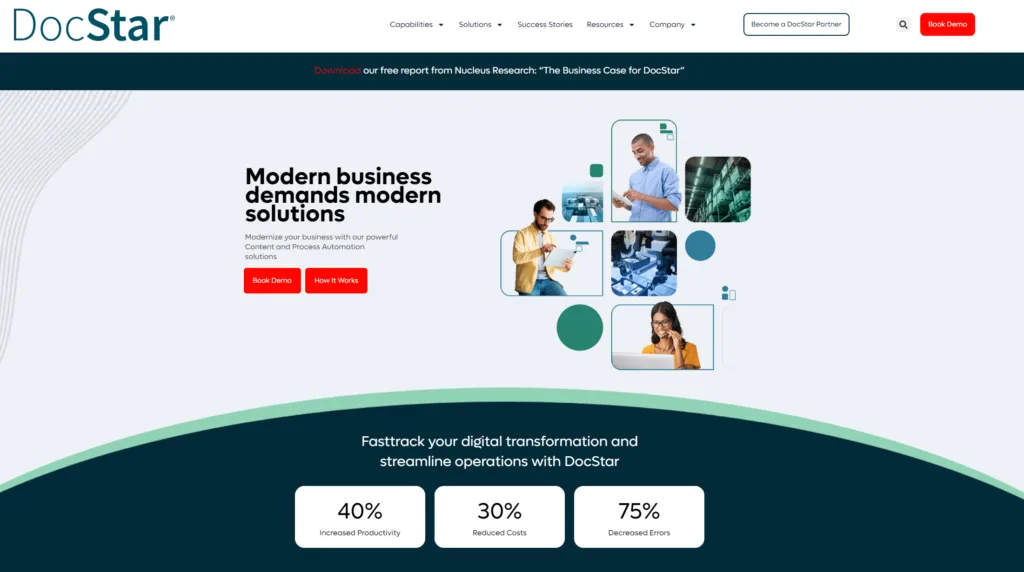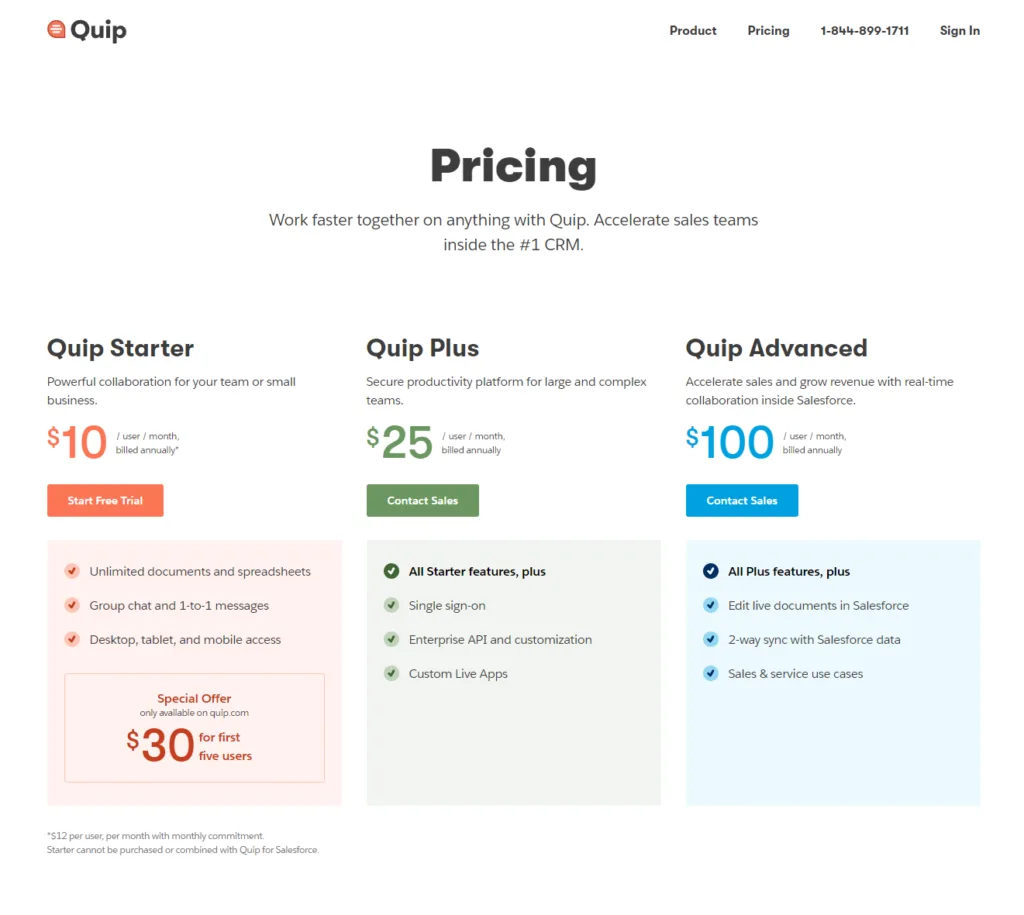In today’s fast-paced business environment, choosing the right document management tool can make a significant difference in your organization’s efficiency. In this article, we’ll dive deep into comparing two popular document management systems: DocStar and Quip. Each offers unique features tailored to different business needs, and we’ll explore which tool might be the best fit for your workflow requirements.
DocStar | Quip |
|---|---|
| G2 Score – 3.7 out of 5 stars | G2 Score – 4.2 out of 5 stars |
| TrustRadius Score – 4.7/10 | TrustRadius Score – 7.6/10 |
Core Functionalities: DocStar vs. Quip
Understanding the core functionalities of a document management system is essential as it directly impacts how you manage, access, and collaborate on documents within your organization. Let’s take a closer look at what DocStar and Quip offer in this regard.
DocStar: Comprehensive Document Management
DocStar is built for businesses that need robust document management capabilities. It offers advanced document storage solutions, including a structured filing system that allows for easy categorization and retrieval. With powerful indexing and search capabilities, users can quickly find documents based on various metadata elements.
One of DocStar’s standout features is its workflow automation. This functionality allows businesses to streamline complex processes such as document approvals, routing, and archiving. By automating these tasks, companies can reduce manual workloads, minimize errors, and ensure operational consistency.
DocStar shines in areas requiring stringent security measures and regulatory compliance. It provides comprehensive security features, including role-based access controls, audit trails, and encryption, ensuring that sensitive documents are protected and compliance standards are met.
Quip: Collaboration-Centric Document Management
Quip integrates document management with real-time collaboration tools. Unlike DocStar, Quip focuses less on traditional file storage and more on how documents are used to facilitate teamwork. Documents in Quip are live, meaning that multiple users can edit and comment simultaneously in a seamless manner.
Quip excels in integrating document management with communication. Each document has a built-in chat feature where team members can discuss edits or updates without leaving the platform. This integration is particularly useful for teams that prioritize communication and quick decision-making.
Quip is designed with a strong emphasis on accessibility and mobility. Being cloud-native, it offers excellent support for businesses that operate remotely or across multiple locations. The Quip app provides a consistent user experience across all devices, ensuring that team members can collaborate effectively, no matter where they are.
Integration Capabilities: DocStar vs. Quip
In a world where software ecosystems are increasingly complex, the ability of a document management tool to seamlessly integrate with other business applications is critical. This integration can significantly enhance productivity and ensure that systems communicate effectively with one another. The integration features of a document management system can make or break its effectiveness, depending on your organization’s reliance on other software tools.
DocStar: Deep Integration with Enterprise Systems
DocStar is known for its strong capability to integrate with a variety of enterprise-level systems, including ERP, CRM, and other business management applications. This is particularly useful for large organizations that rely on a cohesive workflow across multiple platforms. DocStar uses API access to create seamless connections, ensuring that document management is fully embedded into the broader business processes.
Additionally, DocStar allows for custom integrations tailored to specific organizational needs. This flexibility is vital for industries that use specialized software and require their document management system to work in concert with these tools. Custom integrations help streamline workflows, reduce data entry errors, and improve efficiency across departments.
Quip: Integration with Modern Collaboration Tools
Quip shines in its integration with modern, cloud-based collaboration tools such as Slack, Salesforce, and other productivity platforms. By aligning closely with tools that facilitate communication and project management, Quip enhances its functionality as a collaborative workspace, not just a document management system.
Quip’s integrations are not just about connecting systems but also about enhancing the collaborative capabilities within those systems. For example, its integration with Salesforce allows users to create and edit documents directly within a Salesforce record, streamlining workflow and communication within teams.

Related: Check out our free SEO suite

Pricing Models and Customer Support: Assessing Cost Effectiveness and Service Quality
Both DocStar and Quip offer different pricing tiers and customer support levels, aiming to cater to a diverse range of business sizes and needs. Here’s how they stack up.
DocStar: Customizable Pricing for Diverse Needs
DocStar’s pricing is typically based on a per-user model, with costs varying depending on the number of users and the specific features required. This can include options for cloud-based or on-premise installations, each coming with different scaling and pricing implications. DocStar often requires a detailed consultation to provide a customized quote, reflecting the system’s capability to be tailored to specific business processes and requirements.
DocStar prides itself on providing robust customer support, which includes personalized training, an extensive knowledge base, and direct support via phone, email, or live chat. The support level can vary depending on the service package purchased, but all levels are designed to ensure users can maximize the functionality of the system and address any issues swiftly. High-tier customers often receive more dedicated support, which can be critical for businesses relying heavily on their DMS for daily operations.
Quip: Transparent, Subscription-Based Pricing
Quip uses a straightforward subscription-based pricing model that is clear and easy to understand. It typically offers different tiers based on features and the number of users, allowing businesses to scale their use of the system according to their needs. This model is beneficial for businesses looking for predictable costs and the ability to adjust their subscription as their business grows or changes.
Quip provides a comprehensive support system that includes access to an extensive online help center, community forums, and direct customer support via email and chat. The level of direct support may depend on the subscription plan, with premium plans offering more personalized and immediate assistance. This tiered approach ensures that businesses can choose the level of support that best fits their budget and needs.
Scalability and System Performance: Ready for Growth?
Both DocStar and Quip are designed to support business growth, but they do so in different ways, reflecting their distinct approaches to document management.
DocStar: Engineered for Enterprise Expansion
DocStar is built to scale with enterprise-level needs in mind. It can handle a significant increase in document volume and user load without performance degradation. This capability is crucial for large organizations or those with complex document management requirements, as it ensures that the system can grow without impacting operational efficiency.
DocStar’s architecture is robust, designed to maintain high performance even as demands increase. This includes efficient document retrieval, reliable automation workflows, and smooth integration with other enterprise systems. Its performance stability makes it suitable for industries that cannot afford delays or downtime, such as legal, financial, and government sectors.
Quip: Flexible and Adaptive
Quip is inherently scalable, thanks to its cloud-native structure. This design allows it to adapt quickly to changes in user numbers and document loads with minimal need for manual adjustments. Small to medium-sized businesses, in particular, will find Quip’s scalability advantageous as it allows them to expand their usage as they grow without significant upfront investments.
Quip’s performance is optimized for real-time collaboration, ensuring that document access and editing are seamless, even with many users working simultaneously. This is achieved through a lightweight, web-based interface and efficient data handling practices that prioritize speed and responsiveness.
Document Security Enhancements
In an era where data breaches are increasingly common, the security enhancements provided by a document management system are more important than ever.
DocStar: Advanced Security Protocols
DocStar utilizes strong encryption methods for both data at rest and in transit, ensuring that all documents are secure from unauthorized access. This is critical for organizations handling sensitive information.
DocStar offers comprehensive tools designed to aid in compliance with various industry regulations such as HIPAA for healthcare, Sarbanes-Oxley for finance, and GDPR for businesses operating in or dealing with the European Union. These tools include permission settings, audit trails, and retention policies that help maintain strict compliance standards.
Quip: Security with a Focus on Collaboration
While Quip may not offer as extensive compliance-specific tools as DocStar, it provides robust security features tailored to collaborative environments. This includes secure channels for communication within documents, SSL/TLS encryption, and automatic version history to track changes by different users.
Quip integrates security seamlessly into its user experience, ensuring that data protection measures do not hinder collaboration. Its approach to security is designed to be transparent, allowing teams to focus on their work without worrying about the safety of their information.
Customer and Technical Support: Ensuring Smooth Operations
The level of support provided by a document management system can be a deciding factor, especially for organizations that rely heavily on these systems for daily operations.
DocStar: Comprehensive Support for Complex Needs
DocStar offers comprehensive customer support that includes dedicated account managers for higher-tier customers, providing personalized assistance. This is especially valuable for large enterprises or organizations with complex needs, where customized solutions and frequent support interactions are common.
DocStar provides multiple channels for support, including phone, email, and a customer portal where users can submit tickets and track their resolution status. This multi-channel approach ensures that customers can reach support through their preferred method, enhancing the overall service experience.
Apart from reactive support, DocStar places a strong emphasis on proactive education, offering extensive training materials, webinars, and documentation to help users understand and utilize the system effectively. This training can be particularly beneficial for organizations that want to minimize dependence on external support by empowering their staff.
Quip: Streamlined Support for Collaborative Teams
Quip’s support is integrated directly into its platform, with users able to access help resources and submit support tickets without leaving the app. This integration enhances the user experience by providing seamless support interactions.
In addition to direct support from Quip, there is a strong community of users and developers. This community provides a valuable resource for troubleshooting, tips, and best practices, which can be especially useful for common issues or enhancing user knowledge.
Quip offers scalable support options that cater to different business sizes and needs. While basic support is available for all users, premium support packages offer more extensive services, including prioritized responses and direct access to senior support engineers.
Pricing
DocStar:

Quip:

Conclusion
In wrapping up our comprehensive comparison of DocStar and Quip, we’ve dissected multiple dimensions of these document management systems (DMS) to help you determine which tool best fits your organization’s needs. Each system offers distinct benefits tailored to different business environments.
DocStar stands out as a robust, feature-rich document management system designed for organizations that require advanced functionalities such as in-depth document control, complex workflow automation, extensive security measures, and compliance management. It’s particularly suited for industries like healthcare, finance, and government, where such stringent requirements are the norm. DocStar’s ability to provide comprehensive customer support and handle large volumes of documents makes it ideal for larger enterprises or businesses with complex needs.
Quip, on the other hand, excels as a flexible, collaboration-first document management tool. It integrates seamlessly with other cloud-based platforms and fosters real-time collaboration among team members, making it perfect for dynamic, fast-paced work environments. With its strong mobile accessibility and user-friendly design, Quip is well-suited for smaller teams or companies that prioritize ease of use, teamwork, and fluid communication over heavy regulatory compliance.
Read Next:
- GetResponse vs Zoho Campaigns: The Best Email Marketing Tool for 2024
- AWeber vs ActiveCampaign: The Best Email Marketing Tool
- Constant Contact vs Campaigner: Best Email Marketing Tool
- GetResponse vs Omnisend: The Best Email Marketing Tool for 2024
- AWeber vs Benchmark Email: The Best Email Marketing Tool






















Comments are closed.